100
Voted
IMR
2004
Springer
15 years 6 months ago
2004
Springer
A great challenge for flow simulators of new generation is to gain more accuracy at well proximity within complex geological structures. For this purpose, a new approach based on...
102
Voted
IMR
2004
Springer
15 years 6 months ago
2004
Springer
The aim of this paper is to study the feasibility of using (irreversible) entropy production as driving force for a moving mesh. Such a method should be able to capture or track p...
125
Voted
IMR
2004
Springer
15 years 6 months ago
2004
Springer
In this paper, we propose a robust isotropic tetrahedral mesh generation method. An advancing front method is employed to control local mesh density and to easily preserve the ori...
110
click to vote
NPAR
2004
ACM
15 years 6 months ago
2004
ACM
Algorithms that detect silhouettes, creases, and other edge based features often perform per-edge and per-face mesh computations using global adjacency information. These are unsu...
98
Voted
PCM
2005
Springer
15 years 6 months ago
2005
Springer
Recently, various three-dimensional(3-D) mesh coding schemes have been proposed to improve compression efficiency or error resilience. However, we need to consider both coding effi...
101
Voted
IMR
2005
Springer
15 years 6 months ago
2005
Springer
The first stage in an adaptive finite element scheme (cf. [CAS95, bor1]) consists in creating an initial mesh of a given domain Ω, which is used to perform an initial computati...
99
Voted
ICCS
2005
Springer
15 years 6 months ago
2005
Springer
Abstract. This article presents special quadrilateral quadratic refinement elements, which provide geometry and field continuity across Tjunctions where two elements are connecte...
130
click to vote
MMSEC
2005
ACM
15 years 6 months ago
2005
ACM
In this paper, we propose a new fragile watermarking scheme for 3D meshes. Firstly, the watermark information is adaptively embedded into the mesh geometry by slightly adjusting t...
GRAPHITE
2005
ACM
15 years 6 months ago
2005
ACM
We present a meshing and rendering framework for tetrahedral meshes that constructs a multi-resolution representation and uses this representation to adapt the mesh to rendering p...
SIBGRAPI
2005
IEEE
15 years 6 months ago
2005
IEEE
Generating triangular meshes from images is a task important to many applications. Usually, techniques that can do that either take as starting point a segmented image or generate...





